La Paz, short for La Ciudad de Nuestra Señora de La Paz (the City of Our Lady of Peace) was founded on October, 20 1548 by a Spaniard Captain Called Alonso de Mendoza. It’s beginnings were at “Laja” on the Tiwanaku road, but soon after it was moved to the valley of Chuquiago Marka (Rio Choqueyapu).
We will start our visit to La Paz in its Historic Center at La Plaza Murillo. There are various governmental buildings and la Paz Cathedral.
The Plaza Murillo was originally named the Plaza Mayor (Greatest/Main Plaza) after its construction. It was later known during the colonial period as the Plaza de Armas. Following independence, it was renamed the July 16 Plaza (Plaza 16 de Julio) on February 3, 1902, in honor of Pedro Murillo, captured and hung by Spanish troops in January 1810.
Here is a general view by day:

And at night:

El Palacio Quemado
This Neoclasical building served as the Bolivian Palace of Government in two non-consecutive periods, 1853-2018 and 2019-2020, is currently used as a museum. It was designed by the architect José Nuñez del Prado, took 6 years to build. It was inaugurated by the president Isidoro Belzu on March 25, 1853.
Its name means “The burned palace.” It got this name due to a violent attack in which a mob who opposed President Tomás Frías Ametller, set the palace alight after they could not occupy it in 1875. Even though its remodeling began in 1882, by then the name had stuck. Currently this building is used as a museum.

Cr. Wiki Commons, Pancho Fuentes A

This is a close up of the coat of arms you see on the top of the building:

Inside the building it looks like this:

If you wish to explore the area of Plaza Trujillo and see El Palacio Quemado and the Parlament Building go HERE.
The Bolivian Parlament Building

Cr. Wiki Commons: EEJCC
The two chambers of the Bolivian Congress meet in this building on Plaza Murillo. Prior to becoming the seat of the legislature in 1904, the congress building housed a convent and a university.
The Vice-President, in his capacity as President of Congress, has an imposing suite of offices on Calle Mercado in central La Paz. The building, designed by Emilio Villanueva, was erected during the 1920s and was originally intended to serve as the headquarters of Bolivia’s central bank (Banco de la Nación Boliviana).
The building was reassigned to the vice-presidency during Jaime Paz Zamora’s 1989–1993 presidency. The vice-presidential staff did not relocate entirely until major reconstruction and renovation work, starting in 1997, had been carried out. The Library of Congress and the National Congressional Archive are also located on the premises.
An interesting sight is the clock in the spire of the National Congress of Bolivia. The clock runs anti clockwise! So wait… how would that even work?!

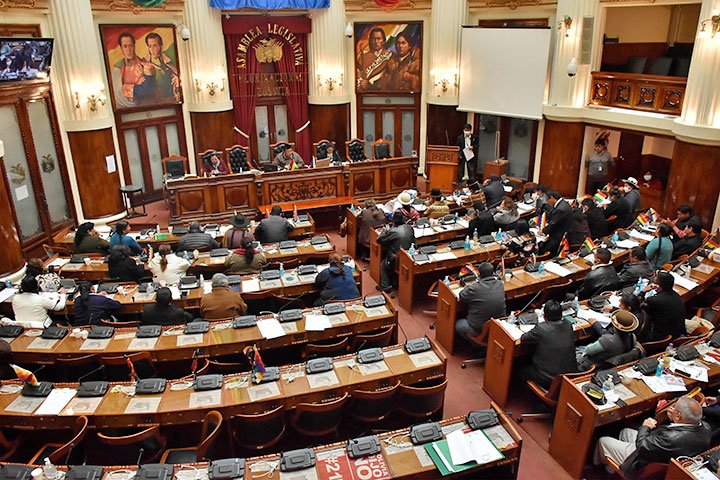
The Cathedral Basilica of Our Lady of Peace
It was built in 1835 with a neoclassical architecture with Baroque elements. It has an interior consisting of five naves with different layers. It’s construction began on March 24, 1835; it was inaugurated in 1925, marking the first centenary of the founding of the Republic of Bolivia. Although it opened that year, its interior ornamentation still continued until 1932.
In 1989, its two lateral towers were opened, this event coinciding with the visit of Pope John Paul II.
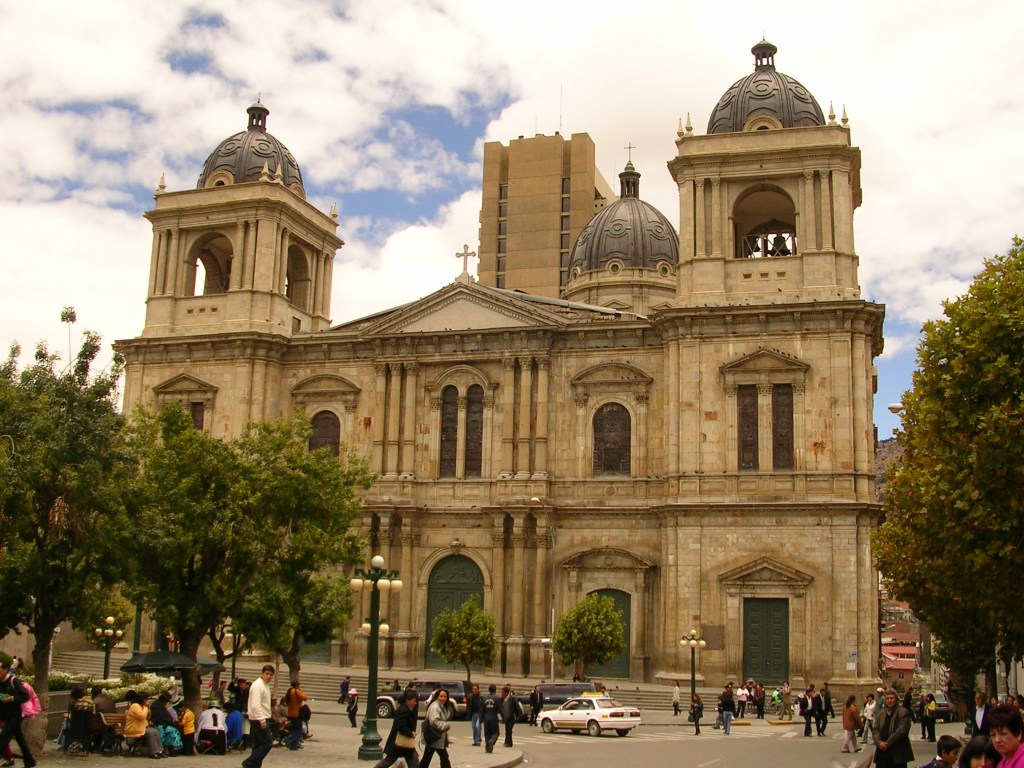

Calle Jaén & Museums
This lovely colonial street is named after Apolinar Jaén, who, along with Pedro Domingo Murillo contributed to the independence movement in Bolivia.
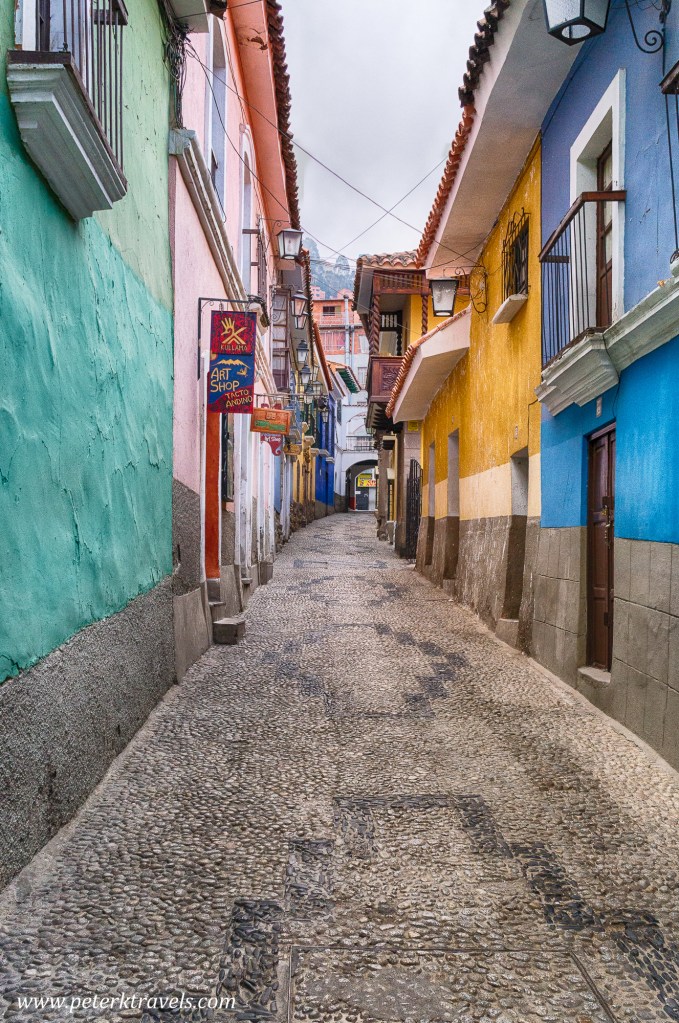



This street houses five small museums that showcase the culture of Bolivians. I will show you two:
Museo Costumbrista
Founded in 1978, this museum looks to show the traditions and culture of Bolivians. It has two floors full of miniatures, masks and memorabilia.


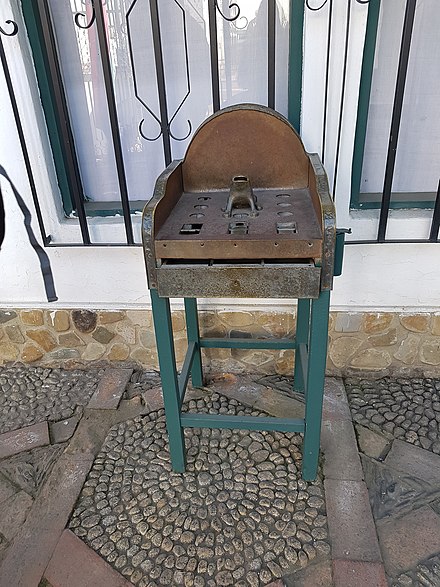

This is a video of the inside. It is in Spanish, but you can see the miniatures.
Museo de Metales Preciosos
This museum, also known as “El Museo del Oro” has four halls filled with impressive ceramic and gold pieces from the Pre-Columbian cultures Aymara, Mollo, Wankarani, Chiripa, Tiwanaku e Inca.

One of if its greatest features is a recent discovered treasure called “El Tesoro de SanSebastian. It is a set of 700 pieces possibly belonging to a high official from the Tiwanacu.

This was found by a geologist named Federico Améstegui and his three sons on a walk made brisk by rainfall in the cityof Cochabamba, in a hill called San Sebastian. One of them spotted one of the gold pieces! This was back in 1916 and it constitutes until this day one of the found treasures ever found in this country.
This is another piece one can view there:

There are also three other museums: el Museo del Litoral, La casa de Murillo and El Museo de los Instrumentos.
The Museo del Litoral houses of historical maps that defend Bolivia’s emotionally charged claims to the area that used to give them access to the Pacific Ocean.
La Casa de Murillo was once the home of Pedro Domingo Murillo, a leader in the La Paz Revolution of July 16, 1809, the Casa de Murillo displays collections of colonial art, furniture and household items of glass and silver that once belonged to Bolivian aristocracy.
El Museo de los Instrumentos Musicales has a small collection of musical instruments from all over Bolivia encompassing varios cultures and time periods.
Museo de Textiles Andinos Bolivianos
This small textile museum has fine examples of the country’s finest traditional textiles including pieces from the Cordillera Apolobamba, and the Jal’qa and Candelaria regions of the Central Highlands. They are organized by region and described in Spanish and English. The creative process is explained from fiber to finished product. There is also a gift shop that sells museum-quality originals and 90% of the sale price goes to the artists.





Basilica of San Francisco
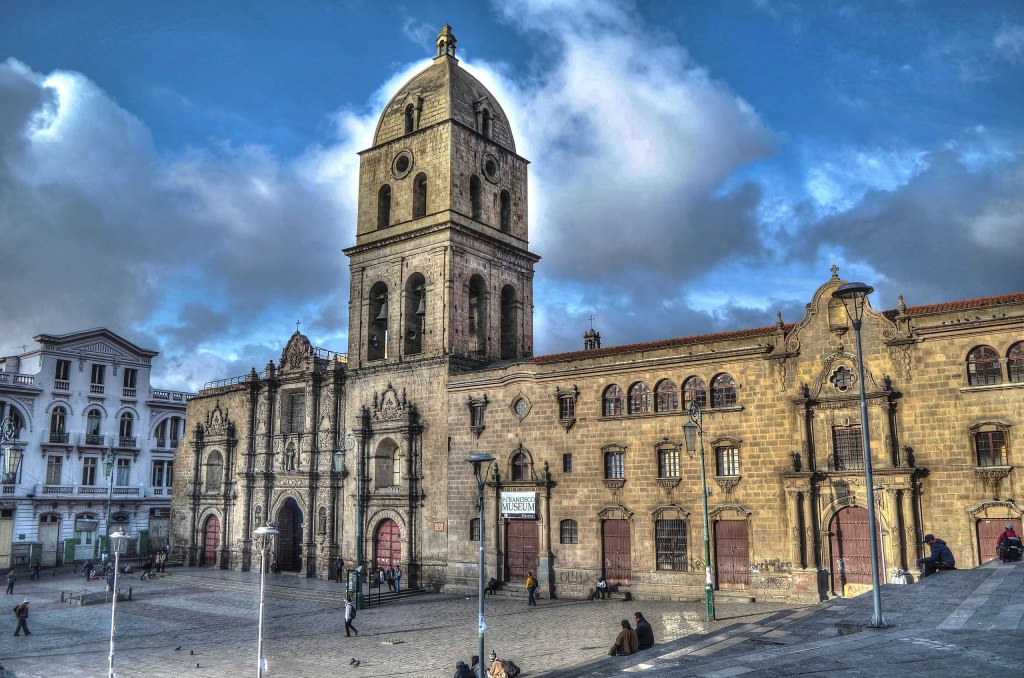
La Basilica of San Francisco in La Paz is a “monor” cathedral dedicated to under the advocation of Francis of Assisi. It had its origins in a convent founded in the same location in 1548, by Fray Francisco de Morales.
The current building was built between 1743-1772 but its tower was built in the end of the 19th century.
The architecture of the temple corresponds to the so-called Mestizo Baroque or Andean Baroque, the plant is of a Latin cross and the roof is vaulted. It has a large atrium that is currently integrated with the adjacent public spaces forming the Plaza Mayor of the city.
The monastery part is now a museum. This is a photo of the cloisters:

This is its interior:

Mercado de la Hechiceria (Witches’ Market)
There are many markets in La Paz, but this one certainly called my attention.
This market is located along the street Jimenez between Sagarnaga and Santa Cruz. It is the ancient Aymara Shaman type of witches, “healers” the ones that would heal the sick with herbal and folk remedies as well as amulets and other traditions.
For example, here you can buy dried toucan beaks intended to protect suplicants from bad spirits. If someone is feeling ill or feeling some bothersome spooks they can purchase colorful herbs, seeds and critters parts to remedy the problem.
Also say you are buying a new house you can buy a llama fetus to bury beneath the cornerstone as a cha’lla (offering) to Pachamama (Mother Earth).
Here are some photos:

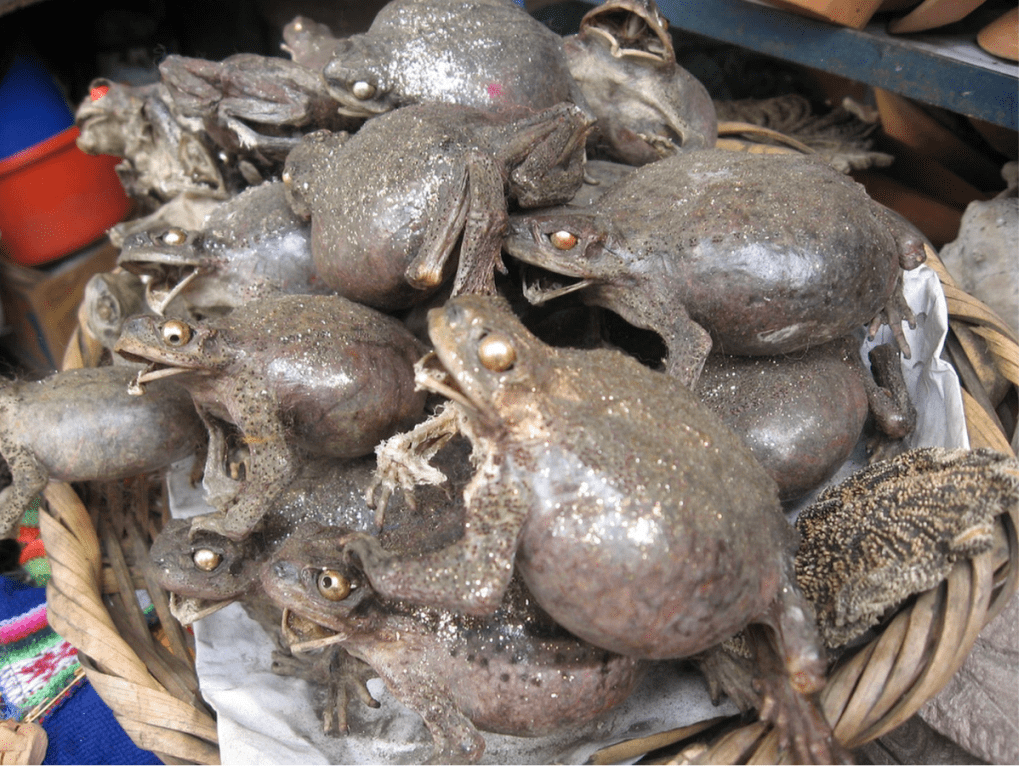
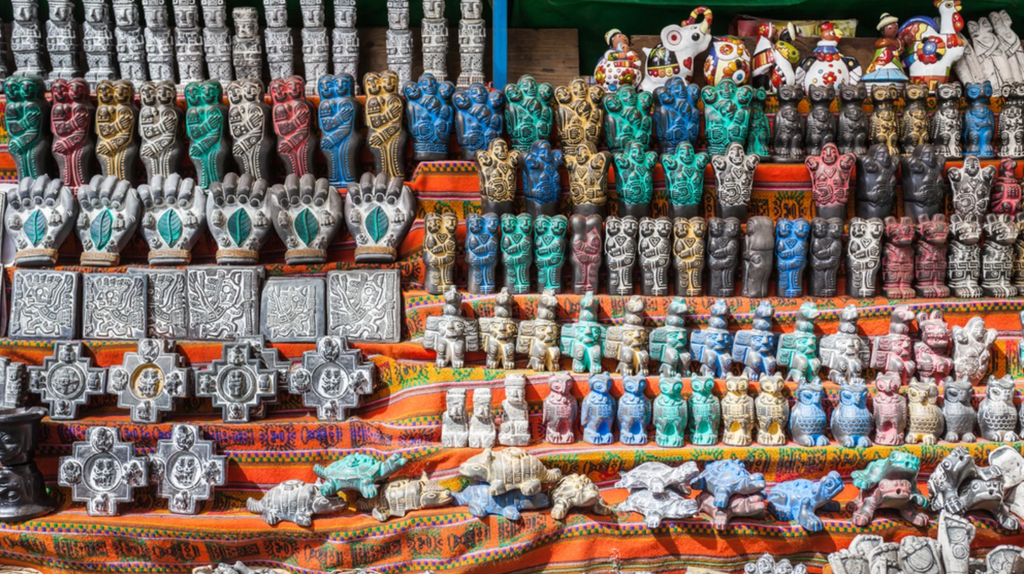
Would you like to visit this place virtually? Go HERE. And head down that street…
Mi teleferico
There is a teleferico or cable car that runs from the city of La paz to El Alto, the next city over (part of La Paz Metro Area) And this is not a small cable car, it is huge!!! Imagine that when it was completed in 2014 it was the longest on in the world at 6.2 miles in length.
In October 2019, the system consists of 26 stations (36 if transfer stations are counted separately per line) along ten lines: Red, Yellow, Green, Blue, Orange, White, Sky Blue, Purple, Brown, and Silver. Further lines and extensions are in planning or construction. (1) They are still working on it and the plan is to have 30 stations with 21 miles and 11 lines!
Mi Teleférico is the first system to use cable cars as the backbone of the urban transit network. In 2018, Mi Teleférico won a Latam Smart City Award in the category of “Sustainable urban development and mobility”. This cable car was a very smart solution to trafic, to having to dig through mountains and it is green. And imagine the views when you are riding! Talking about views, her are some gorgeous views of La Paz and EL Alto.


There is more photos like the last one in a great blog dedicated to these Teleferico views HERE.

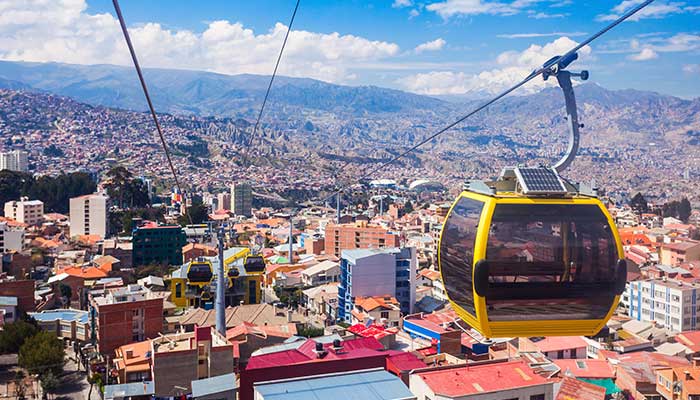
Wondering what the average speed of the cable cars is? I was… it is 11.2 mph (18.0 km/h)(3)


At night… it is so beautiful! This is from an observation area called Mirador de la Virgen Blanca.


And last I leave you with some great views from this and other observations areas around la paz with a local. He has many videos check out his channel!
